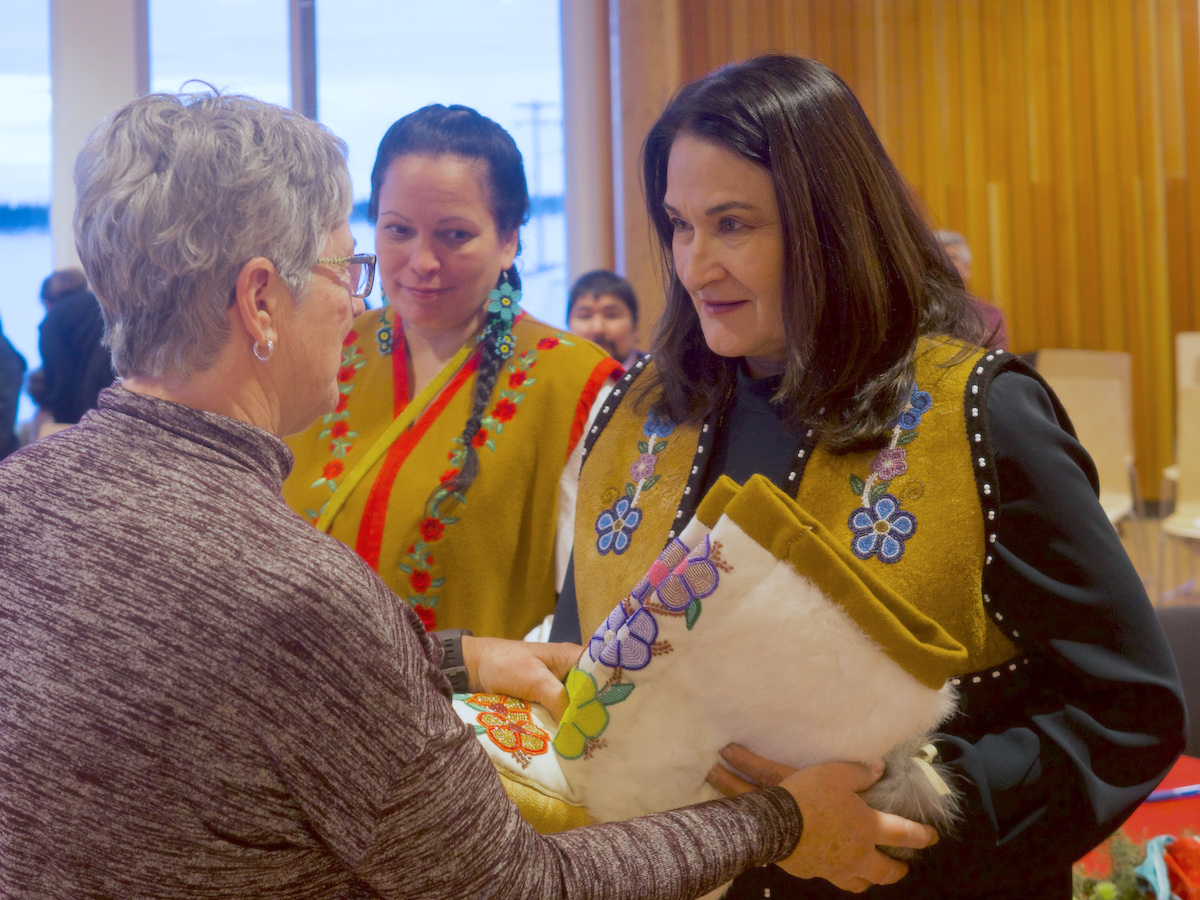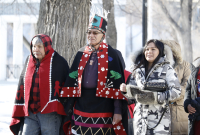Support strong Canadian climate journalism for 2025
The collapse of wild salmon is causing a current of pain that spans the length of the Yukon River, from its mouth at Alaska’s Bering Sea to the headwaters in Canada’s Yukon territory 3,000 kilometres away.
Indigenous people on both sides of the border spoke about the devastation the loss of chinook salmon and the more recent collapse of chum stocks are having on communities while testifying at the Yukon River Panel, a bilateral commission that manages salmon stocks, during its meeting in Whitehorse this week.
Nobody is fishing, said Tiffany Agayar Andrew from the Alaskan village of Alakanuk on the river's delta a short distance from the sea.
All salmon fishing — commercial, recreational and Indigenous food fisheries— has been closed on both sides of the border for the past three years, eroding the well-being, culture, familial ties and food security of Indigenous communities, Andrew said.
Wealth for Alaskan tribes along the river is measured by families coming together at fish camps to catch and prepare salmon. The fish traditionally made up half of the community's winter food stores, she said.

Andrew spoke of the sadness she felt when a friend confessed she was eating once a day in an effort to ration her subsistence food supply, which is especially vital in communities with no road access or grocery stores.
“We can smell the salmon in the river when they're running, but we cannot go out and fish,” Andrew said.
“People can go crazy. But everybody understands that the fish aren’t of the same abundance as they used to be.”
And the dire situation isn’t going to change soon.
Chinook, also known as king salmon, have been declining for over a decade. But last summer’s run was the lowest ever recorded. The loss of the iconic salmon has been compounded by a precipitous drop in fall chum runs, starting in 2020.
Last summer, fewer than 300,000 chum entered the river, down from an average of more than a million fish in years past.
The Yukon River Panel, the bilateral body created in 2002 to collaboratively manage and conserve Canadian salmon stocks, is forecasting another bad year and fishing closures on both sides of the border.
Pre-season estimates suggest 32,000 Canadian chinook may reach spawning grounds this summer, a number well below the current minimum threshold of 42,500 fish.
Even that number is unlikely to arrive, panel members stressed. Last summer, at least 41,000 chinook were forecast to reach Canadian spawning grounds, but fewer than 12,000 made it.
While the situation in the lower portion of the river is becoming increasingly grim, First Nations in the upper reaches of the Yukon watershed have been suffering the disappearance of salmon since the panel was created.
Closures to commercial and recreational fisheries in Canada have been in place for many years. And Yukon territory First Nations have voluntarily ceded their right to fish in a desperate bid to restore salmon and preserve their culture, the panel heard.

Yukon territory First Nations' long sacrifice to save salmon
Ryan Peterson said this summer will mark a decade since he’s harvested salmon.
“I had no problem not fishing knowing what I was doing was for these people here, for their children and for my children,” said Peterson, a councillor for the Tr'ondëk Hwëch'in Nation in Dawson City,
But the ongoing failure of the panel to reach a consensus on the measures necessary to save Yukon salmon is frustrating, he said.
It’s no mystery as to the causes of salmon losses, Peterson said.
“Google it,” he said. “There are three things. Climate change, habit destruction and — number one in my mind is — overfishing. It’s that simple.”
Many Indigenous people along the Yukon are pushing the Alaska Department of Fish and Game (ADF&G) to curtail bycatch in fisheries in the Bering Sea and the Aleutian Islands.
Around 30,000 chinook and half a million chum were caught as bycatch in the pollock fisheries and other ground fish operations in 2021. Fisheries in the region that also target other more abundant salmon like Alaskan pink or sockeye can also inadvertently capture endangered Yukon stocks.
Genetic analysis suggests that less than three per cent of chinook or chum bycatch was headed for the Yukon River and an even lesser amount of those fish stocks destined for Canada.
But every fish matters for Yukon territory First Nations who saw chinook returns of less than 400 fish to tributaries like the Porcupine, Tatchun, Takhini, and Klondike rivers last year.
Teslin Tlingit elder Madeline Jackson said it is necessary to put salmon first before other interests for the sake of future generations.
“I’ve got great-grandkids and they’ve never seen salmon from the lake,” she said.
The community shut fishing down for their children, Jackson said, and if everybody did the same, salmon would multiply.
“Because I want my great-grandchildren to run that net,” she said.
There’s a need for a more collaborative approach on both sides of the border, said Tim Gerberding, chair of the Yukon Salmon Sub-Committee.
Canada supports a more precautionary approach and has long advocated for a long-term closure to fishing along the length of the Yukon on both sides of the border, rather than on an ad hoc basis in bad years, he said.
Ideally, the moratorium would last until stocks have recovered, but Canada is pushing for a pause that would last for at least one life cycle for each species — six years for chinook and four for chum.
But a radical curtailment of Alaskan commercial fishing in the Bering Sea or a commitment to long-term harvesting closures along the river is something the ADF&G and some on the panel have been reluctant to support.
Alleviating fishing pressures isn’t the sole solution, Gerberding said.
Warming waters, disease and hatcheries put cumulative stress on salmon, he said. Many Canadian salmon present in the lower reaches of the river disappear before reaching the border, he added.
The prevailing U.S. theory is that chinook are increasingly affected by Ichthyophonus, a disease that in severe cases causes lesions on the hearts of fish.
Still, there are some measures underway to study and reduce bycatch, Doug Vincent Lang, ADF&G commissioner, told the panel. Like discussions about a possible cap on chum salmon for Alaskan ocean fisheries targeting other abundant salmon stocks. The department is working with the industry to secure voluntary pauses to fishing when chum are passing in numbers, he said.
Lang acknowledged salmon runs on the Yukon had reached “unprecedented” low levels.
“We may not always agree on specifics on how to restore our salmon runs and the users that they support,” Lang said, “but there's a lot of interest in working collaboratively and collegially towards getting chinook salmon, chum salmon and other salmon species … restored.”
There are also strong differences of opinion on the panel about using hatcheries to try to boost salmon stocks, Gerberding said.
Breeding fish for release has been happening worldwide for a long time but has done little to actually rebuild populations. Hatchery fish compete for food with wild stocks and ultimately weaken the physical fitness of threatened salmon, he said.
“They seem like an easy answer, but hatcheries have never really lived up to expectations,” Gerberding said.
Loss from salmon collapse shared end to end on Yukon River

At the end of Tuesday’s panel session, Vuntut Gwitchin Chief Pauline Frost said she was moved by Andrew’s testimony about how the loss of salmon is impacting her village at the mouth of the Yukon.
‘It really resonates for me as a leader here in Canada,” Frost said, noting her community of Old Crow is on the Porcupine River, a tributary at the opposite end of the watershed.
“I can tell you the children in my village are feeling the same thing you are right now,” she said.
Frost assured elders and youth that they were heard as the panel considers measures to manage threatened stocks.
“We acknowledge you and we care,” she said.
“And we will do our utmost to ensure we make the right decisions in the best interest of the salmon.”
Rochelle Baker / Local Journalism Initiative / Canada’s National Observer






Comments